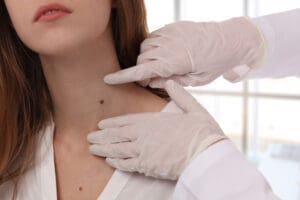Our skin is often a reflection of our overall health, acting as a visible indicator of internal balance or imbalance. While minor changes like occasional dryness or mild irritation are typically harmless, some unusual symptoms may signal underlying health concerns that require medical attention. Persistent rashes, discoloration, or unexplained sensitivity can sometimes point to more serious conditions such as autoimmune disorders, infections, or even systemic diseases. Knowing when to seek medical advice can make a significant difference in preventing and managing skin conditions effectively. In this blog, we’ll explore some uncommon skin symptoms that shouldn’t be ignored and when it’s time to consult a dermatologist.
 Persistent or Unexplained Rashes – Rashes can develop due to a variety of reasons, including allergies, infections, or autoimmune disorders. While many rashes clear up on their own, certain characteristics warrant a visit to a dermatologist:
Persistent or Unexplained Rashes – Rashes can develop due to a variety of reasons, including allergies, infections, or autoimmune disorders. While many rashes clear up on their own, certain characteristics warrant a visit to a dermatologist:
- A rash that lasts longer than two weeks
- Spreading or worsening symptoms
- Painful, itchy, or blistering skin
- Accompanied by fever, fatigue, or joint pain
Skin conditions such as eczema, psoriasis, or lupus-related rashes may require medical attention to prevent complications.
Sudden or Unusual Skin Discoloration – Changes in skin color can indicate several underlying issues. Yellowing of the skin may signal liver disease, while dark patches (hyperpigmentation) could be linked to hormonal changes, Addison’s disease, or certain medications. White patches may suggest vitiligo, an autoimmune condition that causes loss of pigment. If you notice persistent discoloration, consulting a dermatologist can help diagnose the root cause.
Unhealed Wounds or Sores – A wound or sore that doesn’t heal within a few weeks might indicate an underlying problem such as diabetes, poor circulation, or even skin cancer. Chronic wounds, especially those that ooze or bleed, should be evaluated by a dermatologist to rule out infections or malignancies.
 New or Changing Moles – Moles are common, but any sudden changes should raise concern. The ABCDE rule can help assess whether a mole needs medical evaluation. Changes in size, shape, color, or texture can be indicators of melanoma, a serious form of skin cancer. Regularly checking moles and noting any differences is essential for early detection. If a mole appears asymmetrical, has an irregular border, displays multiple colors, exceeds 6mm in diameter, or evolves in any way, it should be examined by a dermatologist. Early detection and treatment can significantly improve outcomes for skin cancer and other dermatological conditions.
New or Changing Moles – Moles are common, but any sudden changes should raise concern. The ABCDE rule can help assess whether a mole needs medical evaluation. Changes in size, shape, color, or texture can be indicators of melanoma, a serious form of skin cancer. Regularly checking moles and noting any differences is essential for early detection. If a mole appears asymmetrical, has an irregular border, displays multiple colors, exceeds 6mm in diameter, or evolves in any way, it should be examined by a dermatologist. Early detection and treatment can significantly improve outcomes for skin cancer and other dermatological conditions.
- A – Asymmetry: One half looks different from the other.
- B – Border: Irregular, jagged, or blurred edges.
- C – Color: Uneven colors, including black, red, blue, or white patches.
- D – Diameter: Larger than a pencil eraser (6mm).
- E – Evolving: Changes in size, shape, color, or texture.
Any mole that bleeds, itches, or grows rapidly should be examined promptly to rule out melanoma.
Excessive Skin Dryness or Peeling – While dry skin is common, excessive or persistent dryness accompanied by peeling, cracking, or pain could indicate an underlying condition such as eczema, psoriasis, or an undiagnosed thyroid disorder. If moisturizers and hydration do not improve the condition, a dermatologist can recommend tailored treatments.
Unexplained Itching – Itching can result from simple dryness, but if it’s chronic, widespread, or occurs without an apparent cause, it might indicate an internal issue. Conditions like liver disease, kidney disease, or even lymphoma can cause persistent itching. If the sensation persists for more than six weeks or interferes with daily life, seeking medical evaluation is crucial.
Sudden Acne Breakouts in Adulthood – Acne is typically associated with adolescence, but if you experience sudden, severe breakouts as an adult, it may be a sign of hormonal imbalances, polycystic ovary syndrome (PCOS), stress, or an underlying medical condition. Certain medications, dietary changes, or environmental factors can also contribute to adult acne. Unlike typical teenage acne, adult breakouts often occur along the jawline, chin, and lower face. Chronic or cystic acne may require professional treatment to prevent scarring and long-term skin damage. Dermatologists can help identify the cause and recommend appropriate treatments, including prescription medications, hormone therapy, or lifestyle adjustments.
Thickened, Discolored, or Ridged Nails – Changes in the nails, such as thickening, discoloration, or unusual ridges, can indicate fungal infections, psoriasis, or systemic diseases like diabetes or anemia. If the nail condition persists despite home treatments, consulting a dermatologist is recommended.
Unexplained Bruising or Skin Sensitivity – Frequent, unexplained bruising or skin that becomes overly sensitive may indicate underlying health concerns like blood disorders, vitamin deficiencies, or connective tissue diseases. If bruises appear easily without injury or your skin feels painful to the touch without a clear reason, medical evaluation is necessary.
 Sudden Hair Loss or Bald Patches – Hair thinning or patchy hair loss can result from stress, hormonal imbalances, autoimmune conditions (such as alopecia areata), or nutritional deficiencies. If you notice significant hair loss, a dermatologist can help determine the cause and suggest treatment options.
Sudden Hair Loss or Bald Patches – Hair thinning or patchy hair loss can result from stress, hormonal imbalances, autoimmune conditions (such as alopecia areata), or nutritional deficiencies. If you notice significant hair loss, a dermatologist can help determine the cause and suggest treatment options.
Our skin often provides early warning signs of deeper health issues. While not every unusual symptom signals a serious problem, it’s important to pay attention to persistent, worsening, or unexplained changes. Left unchecked, some skin conditions can escalate into more severe health concerns, potentially affecting internal organs or signaling systemic diseases. Consulting a dermatologist at the right time can lead to early detection and effective management of skin-related and underlying health conditions. Seeking medical advice promptly not only helps protect your skin but also contributes to your overall well-being. If you experience any of the above symptoms, don’t hesitate to seek our professional advice—your skin’s health may depend on it. Contact us today!

Preventative Boxox in Your 20s
When you hear the word Botox, you probably picture someone smoothing out fine lines and wrinkles that have already formed. Traditionally, Botox has been thought of as a way to turn back the clock —...

Skincare Ingredients to Avoid if You Have Rosacea
If you have rosacea, you know that your skin can feel like it’s walking a tightrope: one wrong step, and you're dealing with stinging, intense redness, or even painful flare-ups that can last for...

Skin Purging vs Breakouts: How to Tell the Difference
If you’ve ever started a new skincare product only to find your skin looking worse before it looks better, you’re not alone. It’s a frustrating experience that often leads to confusion: Is my skin...

The Impact of Hormonal Changes On Skin
Hormones play a crucial role in regulating many bodily functions, and one of the most visible ways they affect us is through our skin. Throughout different life stages—puberty, pregnancy, menopause,...

The Connection Between Diet and Skin Health
The old saying, "You are what you eat," holds a lot of truth when it comes to skin health. Your diet provides the essential nutrients your skin needs to stay resilient, clear, and youthful. What you...

Exploring The Benefits of B12 Injections
In today’s fast-paced world, maintaining optimal health and energy levels is essential for leading a fulfilling and productive life. While proper nutrition and lifestyle habits play significant...

10+ Rare Dermatologic Disorders: From Blue to Self-Peeling Skin
While common skin conditions like acne, eczema, and psoriasis are widely discussed, rare skin diseases like argyria and peeling skin syndrome remain a mystery to most people. Perhaps even you tilted...

